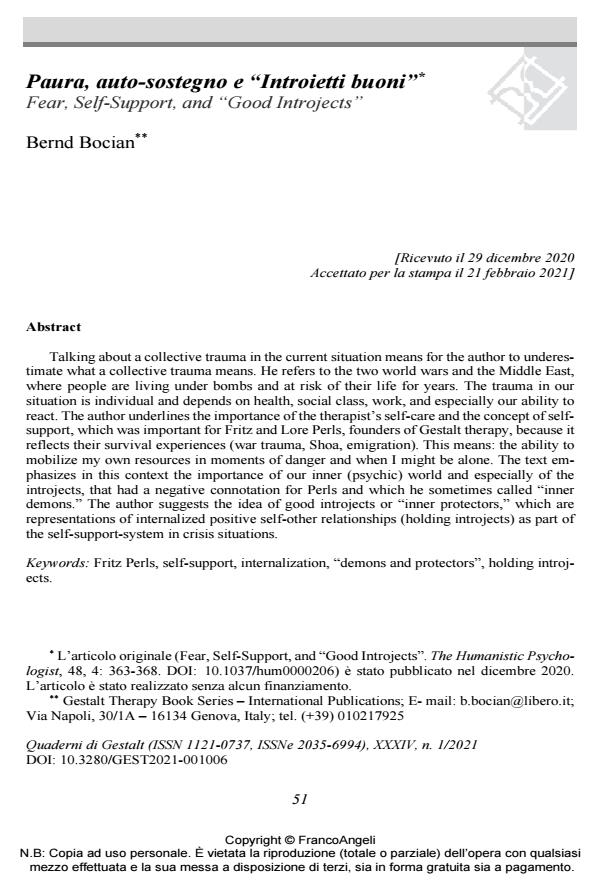Paura, auto-sostegno e "Introietti buoni" Fear, Self-Support, and "Good Introjects"
Titolo Rivista QUADERNI DI GESTALT
Autori/Curatori Bernd Bocian
Anno di pubblicazione 2021 Fascicolo 2021/1
Lingua Italiano Numero pagine 9 P. 51-59 Dimensione file 156 KB
DOI 10.3280/GEST2021-001006
Il DOI è il codice a barre della proprietà intellettuale: per saperne di più
clicca qui
Qui sotto puoi vedere in anteprima la prima pagina di questo articolo.
Se questo articolo ti interessa, lo puoi acquistare (e scaricare in formato pdf) seguendo le facili indicazioni per acquistare il download credit. Acquista Download Credits per scaricare questo Articolo in formato PDF

FrancoAngeli è membro della Publishers International Linking Association, Inc (PILA)associazione indipendente e non profit per facilitare (attraverso i servizi tecnologici implementati da CrossRef.org) l’accesso degli studiosi ai contenuti digitali nelle pubblicazioni professionali e scientifiche
Parlare di trauma collettivo nella situazione attuale per l’autore implica sottovalutare il si-gnificato stesso di trauma collettivo, che invece si può riferire alle due guerre mondiali e al Medio Oriente, dove le persone vivono sotto le bombe e rischiano la vita per anni. Il trauma nella nostra situazione è individuale e dipende dalla salute, dalla classe sociale, dal lavoro e soprattutto dalla nostra capacità di reagire. L’autore sottolinea l’importanza per il terapeuta di prendersi cura di sé. Un altro aspetto che prende in considerazione è il concetto di auto-sostegno, già importante per i fondatori della terapia della Gestalt, Fritz e Lore Perls, perché riflette le loro esperienze di sopravvivenza (trauma di guerra, Shoa, emigrazione). Con il termine auto-sostegno si intende la capacità di mobilitare le risorse personali nei momenti di pericolo e quando potrei essere solo. L’articolo sottolinea, in questo contesto, l’importanza del nostro mondo interiore (psichi-co) e soprattutto degli introietti, che per Perls avevano una connotazione negativa e che a volte chiamava "demoni interni". L’autore suggerisce l’immagine degli introietti buoni o "protettori interni" rappresentazioni di relazioni positive internalizzate sé-altro (introietti di sostegno), come parte di un sistema di auto-sostegno in situazioni di crisi.
Parole chiave:Fritz Perls, auto-sostegno, interiorizzazione, "demoni e protettori", introietti di sostegno
Bernd Bocian, Paura, auto-sostegno e "Introietti buoni" Fear, Self-Support, and "Good Introjects" in "QUADERNI DI GESTALT" 1/2021, pp 51-59, DOI: 10.3280/GEST2021-001006